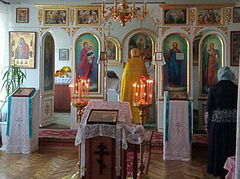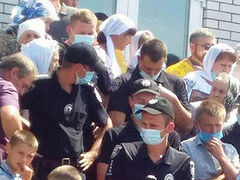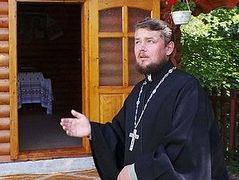August 13, 2020
In Transcarpathia, near Yasinia, the former capital of the short-lived Rusyn Hutsul Republic, a sixty-eight-year-old woman was assaulted by members of the schismatic OCU, right in front of the police. The OCU members have been working to seize the church the woman was attending and defending since 2019.
This is yet another example of the violent church seizures and altercations that go on in Western Ukraine, largely ignored by the world at large.
This conflict in Yasinia of the Rakhiv district began in 2019, around the time a wave of church raids and seizures were reported in Transcarpathia by Ukrainian sources. On February 10, 2019, OCU activists announced a vote had been conducted in the St. Elias the Prophet parish of Yasinia to transfer from the Ukrainian Orthodox Church to the schismatic OCU, claiming that there were 321 votes for, and only 15 against, as Zakarpattya online reported.
At first, this would appear to show clear support for the OCU, however those familiar with the situation in Western Ukraine know all too well how these votes are typically conducted.
On August 10, 2020, in a village in the same Rakhiv district, parishioners of Holy Dormition Church came out in hundreds to defend their churches, saying OCU members are bringing in hundreds of unrelated people from outside their community to sign the petition for the transfer. In particular, the actual parishioners explained that the vast majority of the OCU members had never even visited their parishes let alone been active members.
This is exactly how many of these votes are conducted, with political activists who themselves do not attend any church regularly, coming as OCU supporters flooding into the village from other regions declaring they are members of the parish and will conduct a vote to transfer to the OCU.
Often, when these political OCU supporters are challenged, as in this video, they are unable to even recite basic Orthodox prayers such as the Creed or the Our Father by heart, but they still insist they are members of the “true Ukrainian Church”. This also exposes a serious danger of unchecked congregationalism in Ukraine. There is an initiative to pass local laws which would allow a person to define themselves as a parishioner by self-identification, as opposed to the Church defining her own members. Using this principle, bands of schismatics can simply enter any church, claim they consider themselves to be members, and initiate a legalized church seizure, inviting all their comrades from nearby regions to come by and bolster their numbers.
There is also the problematic local phenomenon of “shared” or “rotating” services, in which schismatics or Uniates attempt to create a legal agreement that they may share the church building with the canonical church. As a well-known Archpriest from western Ukraine Fr. Rostislav Yarema explained, these situations almost always end in the schismatics pushing out the Orthodox completely the moment they gain a foothold.
In these situations, the old adage “possession is nine-tenths of the law”, proves very true, as once schismatics manage to break the padlocks and occupy the parish building itself, they can be very hard to dislodge, as at that point matters are typically not handled by police but passed on to the local court systems, which especially in rural Ukrainian districts can be highly corrupt and tied to local politics. Even in cases when courts or police support the position of the canonical church, the schismatics may not leave.
On August 9, 2020, outside the St. Elias the Prophet parish in the hamlet of Lopushanka near Yasinia, even police presence was unable to prevent the situation from turning violent. Earlier on the feast of St. Elias the Prophet, schismatics came with their “bishop” Varsonophy Rudik and a local TV channel, and in front of the cameras, Rudik predictably called for reconciliation and a shared status of the parish between the Ukrainian Orthodox Church and the OCU. Then on August 9, the lawful rector of the parish Father Sergei, who had already received violent threats from the schismatics, came together with his parishioners and the police to the church, where he showed law enforcement documents proving it belonged to the Ukrainian Orthodox Church.
When the Ukrainian police attempted to escort the canonical community back into their church, an OCU supporter lashed out and assaulted a sixty-eight-year old woman, who had already received threats for being a “pro-Moscow separatist”, in the eyes of schismatics, as the Union of Orthodox Journalists reported.
It is unclear if charges will even be filed, or if they will actually be heard in court, as these types of abuses happen all too frequently and often go unpunished in rural villages in Western Ukraine.
OrthoChristian has been compiling articles on the history of Orthodox Carpathian Rus’, and the Carpatho-Rusyn people, not only because it was from these lands that the bulk of American Russian and Ukrainian Orthodox came from, but also because studying the repeating church history there helps explain the modern Ukrainian situation to us today.




